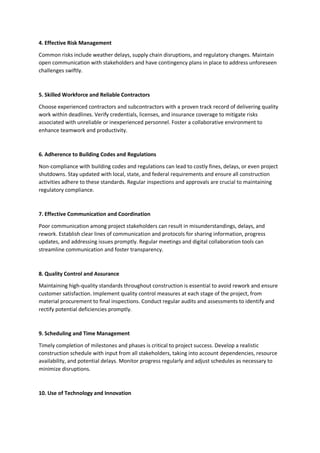

Common pitfalls in home improvement construction projects can derail even the most promising plans. A seemingly straightforward renovation can quickly turn into a frustrating and costly ordeal if not approached with careful planning and execution. Home improvement construction encompasses the various stages involved in transforming a house; this includes everything from interior remodels to exterior additions. This comprehensive guide delves into common issues, offering valuable insights to help homeowners navigate these challenges and ultimately achieve their desired results. You’ll learn to identify potential problems, implement preventive measures, and make informed decisions that save time, money, and stress. This article explores common mistakes, provides detailed explanations, and offers practical solutions to avoid them.
Inadequate Planning and Research:
Poor Planning:
Planning is the bedrock of a successful home improvement project. Without proper planning, the project is prone to delays, cost overruns, and disputes. A solid plan should include a detailed budget, a realistic timeline, and well-defined scope of work. It should outline the expected outcomes and processes involved. A well-defined plan enhances the entire process from start to finish. Avoid common mistakes by investing time in planning.
Insufficient Research:
Thorough research is critical in ensuring the success of your renovation. Before committing to any contractor, research different materials, compare quotes, and check for reviews. Lack of thorough research often leads to unforeseen costs or quality issues.
Lack of Clear Communication:
Communication is crucial between the homeowner and the contractor. A lack of clear communication can lead to misunderstandings, delays, and disputes. Maintaining clear channels of communication throughout the project is essential.
Selecting the Wrong Contractor:
Evaluating Contractors:
Choosing the right contractor is paramount to a successful home improvement project. Assess their experience, reputation, and licensing. Look for licensed and insured contractors with a proven track record. Verify their past projects and references. Seek recommendations from trusted sources. An experienced and reliable contractor will significantly reduce the risk of unforeseen problems. Be wary of contractors who offer suspiciously low bids or lack a clear understanding of your needs.
Unrealistic Expectations:
Be realistic about what you can achieve within your budget and timeline. Setting unrealistic expectations can lead to frustration and disputes with the contractor. Having reasonable expectations and clearly defined goals will make the project more manageable. Discuss these expectations with your contractor to avoid misunderstandings.
Ignoring Building Codes and Regulations:
Unforeseen legal issues often arise when projects are not designed and implemented adhering to building codes and local regulations. A thorough understanding of the local building codes is essential to avoid costly corrections.
Budget and Financing Issues:
Unrealistic Budget:
Developing an accurate and detailed budget is paramount to avoiding financial strain throughout the project. Thoroughly consider all expenses, including materials, labor, permits, and contingency funds. Establish a spending plan that accounts for potential unexpected costs. Creating a comprehensive budget ensures the project stays on track financially.
Inadequate Financing:
Inadequate financing can lead to delays and challenges in sourcing materials and labor. A solid financial plan is essential to support the project’s needs. Ensure you have enough funds to cover the project’s full cost before starting the project. Explore all available financing options to create a sustainable financial plan.
Unforeseen Costs:
Unforeseen costs can arise unexpectedly due to material shortages, design changes, or unanticipated delays. Having a contingency fund will greatly help during these challenging moments. Allocate a portion of your budget to cover potential unforeseen costs.
Time Management and Scheduling:
Inflexible Schedule:
A flexible timeline is crucial for navigating unexpected delays. Delays may result from weather conditions, material sourcing issues, or unforeseen problems. Building flexibility into the schedule can mitigate risks. Allow for buffer time in case of unforeseen challenges.
Lack of Communication:
Clear communication is essential to ensure everyone involved understands the schedule and deadlines. Consistent and clear communication among all parties involved throughout the entire project is important.
Poor Project Management:
Effective project management ensures that the project stays on schedule and budget. Proper project management skills can save time and money by anticipating and addressing potential problems.
Quality Control and Inspection:
Inadequate Quality Control:
Maintaining quality control is essential throughout the project. Consistent quality checks at every stage of the construction process mitigate the risk of defects. Implementing stringent quality control procedures to verify the adherence to standards is essential.
Ignoring Inspection Requirements:
Be sure to follow all inspection requirements at each stage to ensure compliance with building codes and standards. Promptly address any issues identified by the inspectors. Building inspection can often identify issues that, if not addressed, can lead to serious problems down the line.
Lack of Documentation:
Documenting the progress of the project and the quality of the work ensures that all parties have a clear record of the project’s development. Accurate documentation helps resolve potential disputes and ensures accountability among all involved.
Material Selection Issues:
Poor Material Choice:
Improper material selection can lead to issues with durability, aesthetics, and safety. Choose materials that are suitable for the project’s intended use and the local climate. Understand your material options and consider how they will function over time.
Lack of Material Availability:
Material availability is a crucial factor; consider potential disruptions to material supply, particularly during peak seasons. Plan ahead to secure sufficient materials for your project and have a backup plan in case the materials are delayed.
Incorrect Installation:
Incorrect installation can lead to structural problems or aesthetic issues. Ensure that the installation of materials is done by qualified professionals. In some instances, professional installers are essential.
Contractual Disputes:
Unclear Contract Terms:
Contracts should clearly define responsibilities, timelines, and payment terms to prevent misunderstandings. Having a well-defined agreement minimizes ambiguity.
Insufficient Contract Review:
Carefully review all contract terms before signing. Thoroughly understand all the agreements before committing to the terms. Seek legal counsel if necessary.
Breach of Contract:
Understanding the terms of a breach of contract is essential for both parties involved. Know how to address and resolve these issues. Familiarize yourself with local laws and regulations regarding contract disputes.
Dealing with Unexpected Events:
Unanticipated Issues:
Unexpected issues can arise during any project. Have a plan in place to address unexpected challenges. This plan should include contingency funds and alternative solutions.
Weather Conditions:
Unpredictable weather patterns may delay or affect construction. Factor weather conditions into your timelines and have contingency plans ready for adverse conditions.
Change Orders:
Changes in design or scope often lead to change orders. Clearly define the terms of change orders, including costs, timelines, and material alterations. Having a proactive change order process is critical.
Post-Construction Issues:
Quality Concerns:
Post-construction quality issues may occur even after the project is completed. Thorough inspections should occur before final approval. Document all issues and concerns. Follow up promptly on concerns with your contractors.
Warranty Issues:
Warranty information should be carefully reviewed before signing the agreement. Understand any coverage details. Have a plan in place for addressing potential warranty issues.
Maintenance Considerations:
Regular maintenance is vital for the longevity of your home improvement construction project. Establish a plan to maintain your investment properly, understanding proper maintenance procedures. This will prevent costly repairs and keep your project in top shape for years to come.
FAQ:
Q1: What are the most frequent causes of disputes between homeowners and contractors during home improvement projects?
A1: Common disputes arise from a lack of clear communication, poorly defined contracts, and differing expectations regarding timelines, budgets, and quality of work. Misunderstandings about scope of work, materials used, and payment schedules often lead to conflicts. Prioritize comprehensive contracts with detailed specifications and a well-structured communication plan. Be proactive in setting clear expectations and promptly address any concerns. A well-documented project timeline and budget can also prevent potential disagreements later on.
Q2: How can homeowners protect themselves from costly construction errors during home renovations?
A2: To safeguard against costly mistakes, homeowners should prioritize meticulous planning, thorough research, and careful selection of contractors. Begin by seeking multiple bids, carefully evaluating contractor portfolios and references. Thorough contracts should explicitly outline responsibilities, timelines, and payment terms. Consider hiring a qualified architect or engineer for complex projects. They can offer invaluable insight and ensure your project aligns with building codes and standards. Also, establish clear lines of communication from the outset.
In conclusion, avoiding common pitfalls in home improvement construction is crucial for a successful and stress-free project. By diligently planning, researching, and managing your budget and timeline, you can mitigate risks and enjoy the positive outcomes of a well-executed renovation. Consider this your comprehensive guide to successful home improvement construction; now, take action! Learn from the mistakes of others to navigate the complexities of your own home improvement journey. Contact a qualified contractor to discuss your needs, and prepare for a rewarding experience that transforms your home into a space that reflects your style and values.